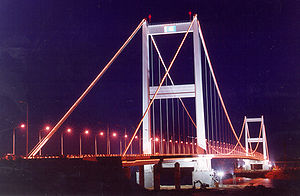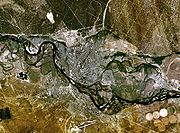
Semey
Encyclopedia


Kazakhstan
Kazakhstan , officially the Republic of Kazakhstan, is a transcontinental country in Central Asia and Eastern Europe. Ranked as the ninth largest country in the world, it is also the world's largest landlocked country; its territory of is greater than Western Europe...
, in the northeastern province of East Kazakhstan, near the border with Siberia
Siberia
Siberia is an extensive region constituting almost all of Northern Asia. Comprising the central and eastern portion of the Russian Federation, it was part of the Soviet Union from its beginning, as its predecessor states, the Tsardom of Russia and the Russian Empire, conquered it during the 16th...
, around 1000 kilometres (621.4 mi) north of Almaty
Almaty
Almaty , also known by its former names Verny and Alma-Ata , is the former capital of Kazakhstan and the nation's largest city, with a population of 1,348,500...
, and 700 kilometres (435 mi) southeast of the Russian city of Omsk
Omsk
-History:The wooden fort of Omsk was erected in 1716 to protect the expanding Russian frontier along the Ishim and the Irtysh rivers against the Kyrgyz nomads of the Steppes...
, along the Irtysh River.
History
The first settlement was in 1718, when the Russians built a fort beside the river Irtysh, near a ruined Buddhist monastery. The monastery's seven buildings lent the fort (and later the city) the name Semipalatinsk (RussianRussian language
Russian is a Slavic language used primarily in Russia, Belarus, Uzbekistan, Kazakhstan, Tajikistan and Kyrgyzstan. It is an unofficial but widely spoken language in Ukraine, Moldova, Latvia, Turkmenistan and Estonia and, to a lesser extent, the other countries that were once constituent republics...
for Seven-Chambered City). The fort suffered frequently from flooding caused by the snowmelt swelling the Irtysh, and in 1778 the fort was relocated 18 km upstream to less flood-prone ground. The small city grew around the fort, largely servicing the river trade between the nomadic peoples of Central Asia
Central Asia
Central Asia is a core region of the Asian continent from the Caspian Sea in the west, China in the east, Afghanistan in the south, and Russia in the north...
and the growing Russian Empire
Russian Empire
The Russian Empire was a state that existed from 1721 until the Russian Revolution of 1917. It was the successor to the Tsardom of Russia and the predecessor of the Soviet Union...
. The construction of the Turkestan-Siberia Railway
Turkestan-Siberia Railway
The Turkestan–Siberian Railway is a broad gauge railway that connects Central Asia with Siberia. It starts north of Tashkent in Uzbekistan at Arys, where it branches off from the Trans-Caspian Railway. It heads roughly northeast through Shymkent, Taraz, Bishkek to the former Kazakh capital of...
added to the city's importance, making it a major point of transit between Central Asia and Siberia.
Between 1917 and 1920, it was the capital of the largely unrecognized Alash Autonomy
Alash Autonomy
Alash Autonomy was a state that existed between December 13, 1917 and August 26, 1920, located roughly on the territory of present day Republic of Kazakhstan. The capital city was Semey ....
, a state formed during the Russian Civil War
Russian Civil War
The Russian Civil War was a multi-party war that occurred within the former Russian Empire after the Russian provisional government collapsed to the Soviets, under the domination of the Bolshevik party. Soviet forces first assumed power in Petrograd The Russian Civil War (1917–1923) was a...
. The city was called Alash-qala during the Alash Autonomy years. It was recaptured by Red Army
Red Army
The Workers' and Peasants' Red Army started out as the Soviet Union's revolutionary communist combat groups during the Russian Civil War of 1918-1922. It grew into the national army of the Soviet Union. By the 1930s the Red Army was among the largest armies in history.The "Red Army" name refers to...
forces loyal to Petrograd in 1920.
In 1949, a site on the steppe
Steppe
In physical geography, steppe is an ecoregion, in the montane grasslands and shrublands and temperate grasslands, savannas, and shrublands biomes, characterized by grassland plains without trees apart from those near rivers and lakes...
150 km (93.2 mi) west of the city was chosen by the Soviet atomic bomb programme
Soviet atomic bomb project
The Soviet project to develop an atomic bomb , was a clandestine research and development program began during and post-World War II, in the wake of the Soviet Union's discovery of the United States' nuclear project...
to be the location for its weapons testing. For decades, Kurchatov
Kurchatov, Kazakhstan
Kurchatov is a town in East Kazakhstan Province in northeast Kazakhstan. Named after Soviet nuclear physicist Igor Kurchatov, the town was once the centre of operations for the adjoining Semipalatinsk Test Site...
(the secret city at the heart of the test range named for Igor Kurchatov
Igor Kurchatov
Igor Vasilyevich Kurchatov , was a Soviet nuclear physicist who is widely known as the director of the Soviet atomic bomb project. Along with Georgy Flyorov and Andrei Sakharov, Kurchatov is widely remembered and dubbed as the "father of the Soviet atomic bomb" for his directorial role in the...
, father of the soviet atomic bomb) was home to many of the brightest stars of Soviet weapons science. The Soviet Union
Soviet Union
The Soviet Union , officially the Union of Soviet Socialist Republics , was a constitutionally socialist state that existed in Eurasia between 1922 and 1991....
operated the Semipalatinsk Test Site
Semipalatinsk Test Site
The Semipalatinsk Test Site was the primary testing venue for the Soviet Union's nuclear weapons. It is located on the steppe in northeast Kazakhstan , south of the valley of the Irtysh River...
(STS) from the first explosion in 1949 until 1989; 456 nuclear tests, including 340 underground and 116 atmospheric tests, were conducted there.
Semey has suffered serious environmental and health effects from the time of its atomic prosperity: nuclear fallout from the atmospheric tests and uncontrolled exposure of the workers, most of whom lived in the city, have given Semey and neighboring villages high rates of cancer
Cancer
Cancer , known medically as a malignant neoplasm, is a large group of different diseases, all involving unregulated cell growth. In cancer, cells divide and grow uncontrollably, forming malignant tumors, and invade nearby parts of the body. The cancer may also spread to more distant parts of the...
, childhood leukemia
Leukemia
Leukemia or leukaemia is a type of cancer of the blood or bone marrow characterized by an abnormal increase of immature white blood cells called "blasts". Leukemia is a broad term covering a spectrum of diseases...
, impotence and birth defects.
Modern Semey is a bustling university town with a population exceeding 300,000. Its proximity to the border, and the large expatriate scientific community attached to the university and the STS labs, gives Semey a more Russian character than other Kazakh cities.
The oblast
Oblast
Oblast is a type of administrative division in Slavic countries, including some countries of the former Soviet Union. The word "oblast" is a loanword in English, but it is nevertheless often translated as "area", "zone", "province", or "region"...
of Semipalatinsk has been merged with the bigger East Kazakhstan Province, whose capital city is Oskemen
Oskemen
Oskemen and Ust-Kamennaya , is the capital of the East Kazakhstan Province. It is served by the Ust-Kamenogorsk Airport.-History:...
.
The Semipalatinsk Bridge
Semipalatinsk Bridge
The Semipalatinsk Bridge is a gravity-anchored suspension bridge that crosses the Irtish river in Semipalatinsk, Kazakhstan. It has a main span of 750 meters and a total length of 1086 m....
, a suspension bridge across the Irtish River, connects two major parts of Semey. It has a main span of 750 metres (2,460.6 ft) and a total length of 1086 metres (3,563 ft). It was built between 1998 and 2002 and is currently in use by road traffic.
Famous residents
- Abay Qunanbayuli, father of modern Kazakh poetry, received his Russian schooling at Semey.
- Writer Fyodor Dostoyevsky, whose exile included five years military service as a corporal in the Seventh Line Battalion at the Semipalatinsk garrison, beginning in 1854. Residents claim the details of particular descriptive passages in Dostoyevsky's subsequent books, including his highly acclaimed The Brothers KaramazovThe Brothers KaramazovThe Brothers Karamazov is the final novel by the Russian author Fyodor Dostoyevsky. Dostoyevsky spent nearly two years writing The Brothers Karamazov, which was published as a serial in The Russian Messenger and completed in November 1880...
, are recognizable as taken from his time in Semey. - Boxer Wladimir KlitschkoWladimir KlitschkoWladimir Klitschko is a Ukrainian heavyweight boxer. Klitschko is the WBA , IBF, WBO Super, IBO & Ring Magazine Champion. His older brother Vitali Klitschko is the current WBC champion...
, who was born there in 1976.
The city has a museum to commemorate Abay Qunanbayuli, and has both a museum of and a street named after Dostoyevsky.
Population
| Year | Population |
|---|---|
| 1881 | 17,820 |
| 1897 | 26,353 |
| 1910 | 34,400 |
| 1926 | 56,100 |
| 1939 | 109,700 |
| 1959 | 149,800 |
| 1979 | 270,400 |
| 1989 | 317,100 |
| 1999 | 269,600 |

